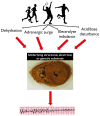Sudden Cardiac Death in Athletes: Facts and Fallacies
- PMID: 36826564
- PMCID: PMC9965876
- DOI: 10.3390/jcdd10020068
Sudden Cardiac Death in Athletes: Facts and Fallacies
Abstract
The benefits of exercise for cardiovascular and general health are many. However, sudden cardiac death (SCD) may occur in apparently healthy athletes who perform at the highest levels. A diverse spectrum of diseases is implicated in SCD in athletes, and while atherosclerotic coronary artery disease predominates in individuals of >35 years of age, primary cardiomyopathies and ion channelopathies are prevalent in young individuals. Prevention of SCD in athletes relies on the implementation of health policies aimed at the early identification of arrhythmogenic diseases (such as cardiac screening) and successful resuscitation (such as widespread utilization of automatic external defibrillators and training members of the public on cardiopulmonary resuscitation). This review will focus on the epidemiology and aetiologies of SCD in athletes, and examine fallacies in the approach to this controversial field. Furthermore, potential strategies to prevent these tragic events will be discussed, analysing current practice, gaps in knowledge and future directions.
Keywords: athlete’s heart; cardiomyopathy; channelopathy; sports cardiology; sudden arrhythmic death syndrome; sudden cardiac death.
Conflict of interest statement
The authors declare no conflict of interest.
Figures




References
-
- Radford N.B., DeFina L.F., Leonard D., Barlow C.E., Willis B.L., Gibbons L.W., Gilchrist S.C., Khera A., Levine B.D. Cardiorespiratory Fitness, Coronary Artery Calcium, and Cardiovascular Disease Events in a Cohort of Generally Healthy Middle-Age Men: Results From the Cooper Center Longitudinal Study. Circulation. 2018;137:1888–1895. doi: 10.1161/CIRCULATIONAHA.117.032708. - DOI - PubMed
-
- Shah R.V., Murthy V.L., Colangelo L.A., Reis J., Venkatesh B.A., Sharma R., Abbasi S.A., Goff D.C.J., Carr J.J., Rana J.S., et al. Association of Fitness in Young Adulthood With Survival and Cardiovascular Risk: The Coronary Artery Risk Development in Young Adults (CARDIA) Study. JAMA Intern Med. 2016;176:87–95. doi: 10.1001/jamainternmed.2015.6309. - DOI - PMC - PubMed
-
- Hussain N., Gersh B.J., Gonzalez Carta K., Sydo N., Lopez-Jimenez F., Kopecky S.L., Thomas R.J., Asirvatham S.J., Allison T.G. Impact of Cardiorespiratory Fitness on Frequency of Atrial Fibrillation, Stroke, and All-Cause Mortality. Am. J. Cardiol. 2018;121:41–49. doi: 10.1016/j.amjcard.2017.09.021. - DOI - PubMed
Publication types
LinkOut - more resources
Full Text Sources
Medical

